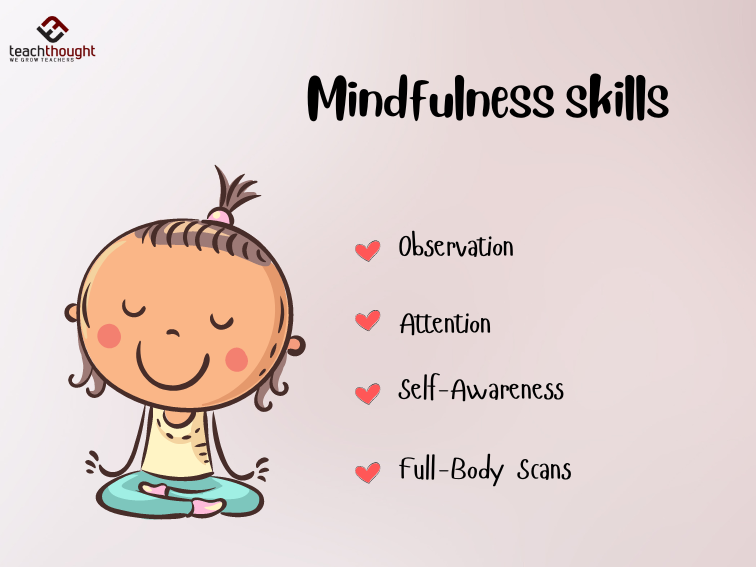A Preface By TeachThought Staff
What Are Mindfulness Skills?
Mindfulness skills include observation, attention, self-awareness, types of breathwork, guided imagery, and the Full Sensory Self Check-in.
While meditation usually requires sitting, mindfulness can be done doing anything–that is, we can be ‘mindful’ while walking, eating, driving, brushing our teeth, etc. Being mindful simply means to be fully present using observation and self-awarness to bring attention to the richness and of–well, almost anything.

The Full-Body Scan As A Mindfulness Strategy
contributed by Dr. Domenico Meschino, Teacher, Author, Social Scientist
As we progress through our daily lives we are constantly exposed to sources of stress–responsibilities, work-related projects and deadlines, family interactions, and multiple personal interactions.
Finding ways to alleviate this stress is imperative for maintaining good mental and physical health. The Full Sensory Self Check-In is a simple strategy we can all use to center ourselves during those moments. Following these steps will help us connect with our senses and emotions, take a break from external influences, and seek balance and clear mindedness.
The Full Sensory Self Check-In can be beneficial for all of us: It can provide much-needed mental and emotional regeneration, and it can alleviate stress headaches, loss of appetite, and any other physiological symptoms of our lifestyle. This strategy can also present a breakthrough for students and teachers. If taught well, it can provide immediate improvements in classroom management, students’ achievements, and the quality of the learning.
See also 30 Teacher Prompts For Well-Being
When you have a minute to take a break or have even a few seconds, close your eyes, and take a deep breath. Inhale for as long as you can, and exhale as slowly as possible, focusing entirely on your breathing. Then, keeping your eyes closed, focus on one sense at the time. For example, first focus on touch. All your attention and mind’s focus are on the tactile sense. Rub your fingers together slowly or touch anything around you–a chair, your clothes, or anything in your immediate proximity. Just a few seconds are enough if you are totally focused on the tactile sense.
Afterward, keep your eyes closed and move onto another sense. Put all your energy into your hearing sense. Maintaining your breath steady, your mind should be concentrated on your hearing. Hear as much as you can and as distinctly as you can. Imagine your eardrums opening and expanding in power. This moment of focusing should last another few seconds.
Now, it’s time to move on to taste. Direct all your attention, moving your tongue around, and check in with your tasting sense. Continue breathing and focus your mind on the taste in your mouth, eliminating any other thoughts in your mind, and allowing yourself to sink into relaxation.
Next, it is time for your emotional check-in. In this relaxed state, ask yourself how you are feeling: check in with your inner emotions and isolate all the variables affecting the way you feel. Just feel for a moment. Take this moment to feel good about yourself and what you are doing. Allow yourself to feel centered; set aside your negative emotions, and simply feel.
See also Pause, Reflect, Adjust: A Strategy For Well-Being
It is now time for your sense of sight. Until now, you’ve kept your eyes closed to better focus on other senses. It is now time to open them and focus entirely on the observable world. Open your eyes and look around. Try to appreciate the environment around you with a different attitude. Appreciate the gift of sight; look at the details around you and become more aware of your surroundings.
Lastly, it is time to bring it all together while taking a deep breath. Focus on all your senses at one time: touch, taste, hearing, feeling, and sight. Your senses should be enhanced at this point in the exercise, and you should feel relieved and rejuvenated. You should feel more centered, balanced, and feel far more in touch with the reality around you. Like everything else, you will get better and better the more you consciously practice your self-check-in.
This exercise can also be carried out by checking one sense at a time. While experiencing moments of anger, frustration, or excessive worrying, close your eyes, if feasible, and carry out the deep breathing exercise. Then, move your entire focus to one sense only. The longer you focus, the more you can empty your mind. Those moments of non-thinking will provide you with useful a break and allow you to get back within yourself in a calmer, and less agitated way. Now you are better equipped to carry out the emotional check-in.
The check-in can be enhanced with self-talk during very challenging situations. Self-calming or soothing words with the goal of establishing balance and removing extreme tensions and anger. “You will feel better soon. You are okay. You are breathing. You are safe. You are alive. It’s good, just keep breathing. You will feel better. We will deal with the issues when they present themselves with a clear and cool head.”
See also What Anxiety Feels Like To Me
This Full Sensory mindfulness activity, combined with the ‘non-thinking zone’ with self-talk/internal dialogue, represents a very important asset for teachers’ and students’ academic and personal future.